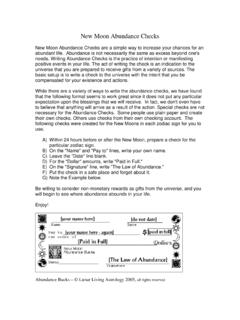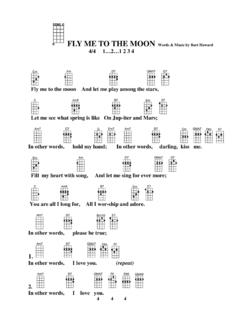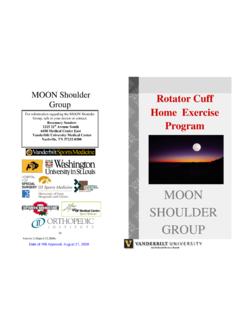Transcription of PLANTING BY THE MOON - PLANTanswers
1 PLANTING BY THE moon "Shine on, Shine on harvest moon " is the song lyric which Texans can sing most of the year because of the long production period. Most growers ignore the phases of the moon when the time for PLANTING activities is optimum. Whether or not that is wise is a matter of opinion. The moon and its phases are credited by some for the success or failure of plant growth. For every researcher who has disproved any effects of the moon on plant growth, there are probably several hundred growers who staunchly support and give testimony to the miraculous advantages of " PLANTING by the moon ." I will neither condemn nor condone PLANTING by the moon . I find that condemning an age-old practice which cannot be unequivocally proven or disproved is risky and foolish. Scientists are discovering the effects of lunar rhythms on the earth's magnetic field which in turn affect growth.
2 They have established that all water everywhere, including that inside the tiniest living organism, moves in tides like the sea. The moon also affects the earth's atmosphere so that statistically it is more likely to rain heavily immediately after a full or a new moon . They say that a potato grown at constant levels of heat and light under laboratory conditions will still show a growth rhythm that reflects the lunar pattern. Yet condoning a practice which would make the practicalities of commercial agriculture impossible is equally as foolish. So my advice about PLANTING -by-the- moon is "Do what you want to do!", "Do your own thing!", and "If it feels good, do it!". Common sense should also be incorporated into the PLANTING -by-the- moon philosophy. The danger of using the moon solely as a PLANTING guide is that regional timing and environmental conditions are often overlooked.
3 For instance, according to Llewellyn's moon Sign Book, June is an excellent time to plant potatoes - - try to plant potatoes during June in Texas and get ready for a real disaster! Many crops require certain ranges of soil temperatures before proper seed germination will occur. Some crop such as potatoes tolerate and produce best in cool temperatures while some require warm temperatures. Some crops tolerate cold while others are killed by the lightest frost. So obviously the environment and proper timing to achieve the optimum growing conditions must be taken into account when moon dates are considered. If you still want to try PLANTING -by-the- moon techniques you will have to juggle moon phases and moon signs. moon phases involve such things as: Increasing light: From New moon to Full moon -- plant annuals that produce their yield above the ground.
4 An annual is a plant that completes its entire life cycle within one growing season, and has to be seeded anew each year. Decreasing light: From Full moon to New moon plant biennials, perennials, bulb, and root plants. Biennials include crops that are planted one season to winter over and produce crops the next, such as winter wheat. Perennials, bulb and root plants include all plants that grow from the same root year after year. A simple, though less accurate, rule is to plant crops that produce below-ground during the decrease of the moon . This is the source of the old adage: "Plant potatoes during the dark of the moon ." First Quarter (increasing from New moon to about half-full): Plant annuals producing their yield above ground, which are generally of the leafy kind that produce their seed outside the fruit -- also seed cereals and grain.
5 Examples are asparagus, broccoli, cabbage, cauliflower, celery, corn, endive, lettuce, onions, spinach, etc. As an apparent exception to the rule, cucumber seems to do best in the First Quarter rather than in the Second, even though the seeds are inside the fruit. Second Quarter (increasing from about half-full to Full moon ): Plant annuals producing their yield above ground, which are generally of the vine kind that produce their seed inside the fruit. Examples include beans, eggplant, peas, peppers, squash, tomatoes, and watermelon -- also cereals and grains, again. These are not hard-and-fast divisions. If you can't plant during the First Quarter, you will be safe to plant during the Second, and vice versa. And, there are many plants which seem to do equally as well planted in either quarter, such as watermelon, garlic, hay, and as indicated - cereals and grains.
6 Third Quarter (decreasing from Full moon to about half-full): Plant biennials, perennials, and bulb and root plants, including crops planted in one season to winter over and produce their crops the next season. Also, trees, shrubs, berries, beets, carrots, onion sets, potatoes, radish, rhubarb, rutabaga, turnip, winter wheat, grapes, etc. fare well. Fourth Quarter (decreasing from half-full to New moon ): Best for cultivation, pulling weeds; and destroying pests of all kinds, turning sod, when the moon is one of the barren signs. The preceding moon phases must be carefully coordinated with zodiacal signs. These signs represent any of twelve divisions of the zodiac, each denoted by the name of a constellation or its symbol. PLANTING -by-the- moon or figuring out when to plant by the moon is not as easy as some believe it to be.
7 You should also realize that environmental factors and timing must be considered if success is expected. Since many of you are not familiar with the proper timing for fruit and vegetable PLANTING , I have formulated the following moon PLANTING guide which gives what to plant and when to plant it to get full benefit of the moon while still being acclimated to local conditions: ===================================== Optimum Spring Optimum Fall Crops Phase Sign PLANTING Dates PLANTING Dates broccoli, cabbage, 1 Cancer, Scorpio, February August cantaloupe, kohlrabi, Pisces, Libra April September lettuce, okra, water- May October melon, corn, cucumbers, June herbs berries.
8 Deciduous 2 Cancer, Scorpio, January July trees, vines, grapes, Pisces February August herbs, melons, tomatoes, March September * squash April May June beans, peas, cantaloupe, 2 Cancer, Scorpio, February July watermelon Pisces, Libra March August April September May ** June peppers 2 Scorpio, April July Sagittarius May August* June peach, pear, plum 2,3 Pisces.
9 Taurus January August (grown in containers) September beets, carrots, turnips 3 Cancer, Scorpio, Pisces, Libra February October March November April potatoes 3 Cancer, Scorpio, February * August Libra, Taurus.
10 September Capricorn, March ** Sagittarius April ** radish 3 Pisces, Libra, August Taurus, Capricorn, February September Sagittarius March October April onion sets 3,4 Pisces, Libra, Not recommended Taurus February March ** Rutabagas 3 Cancer, Scorpio.








